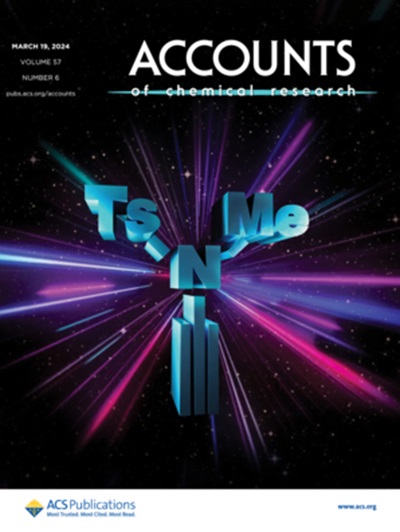Glycome-Proteome Interactome Cartography via Proximity Tagging.
IF 17.7
1区 化学
Q1 CHEMISTRY, MULTIDISCIPLINARY
引用次数: 0
Abstract
ConspectusGlycans are now recognized as essential biomolecules for life, and an increasing number of investigators and studies continue to reveal the myriad ways in which these post-translational modifications regulate important biological events. Chief among the ways in which glycans carry out their roles is by engaging in binding interactions with glycan-binding proteins (GBPs). Such interactions are important for proper physiology or in the activation of disease. Thus, achieving a precise molecular understanding of these interactions can pave new avenues for synthetic control and potentially therapeutic strategies to regulate disease. In this Account, we discuss our efforts toward revealing the collective interactions between glycans, protein glycoconjugates, and GBPs in cells, with an eye toward identifying the specific glycan-carrying proteins that interact with the GBPs in a functional manner.While the importance of studying glycan-GBP interactions has long been established, prior to our work, much of glycoscience had been occupied with the systematic assignment of the structural features of glycans required for recognition by GBPs in vitro, often using homogeneous glycan arrays. This important body of work enabled the preliminary identification of principal GBP-glycan binding preferences and allowed the rational design of functionalized glycan molecules to use as competitive inhibitors. Equipped with these two sets of important tools, expanding our understanding of glycan-GBP interactions from in vitro glycan binding preferences toward that of glycoprotein-GBP interactions in vivo has become timely and possible. We describe the conceptual motivation behind developing proximity tagging technologies to capture these glycoprotein-GBP interactions and how we used these interactome data sets to guide the discovery of functional interactors or create new hypotheses. Furthermore, we describe how proximity tagging can continuously be used toward application in our work, and the potential routes of investigation it may facilitate in the coming years.通过接近标记的糖-蛋白质相互作用组制图。
聚糖现在被认为是生命必需的生物分子,越来越多的研究者和研究继续揭示这些翻译后修饰调节重要生物事件的无数方式。聚糖发挥作用的主要方式是与聚糖结合蛋白(GBPs)进行结合相互作用。这种相互作用对于正常的生理或疾病的激活是重要的。因此,实现对这些相互作用的精确分子理解可以为合成控制和潜在的治疗策略铺平新的道路,以调节疾病。在这篇文章中,我们讨论了我们在揭示细胞中聚糖、蛋白糖缀合物和GBPs之间的集体相互作用方面所做的努力,并着眼于识别以功能方式与GBPs相互作用的特定聚糖携带蛋白。虽然研究聚糖- gbp相互作用的重要性早已确立,但在我们的工作之前,糖科学的大部分工作都是系统地分配体外GBPs识别所需的聚糖的结构特征,通常使用均相聚糖阵列。这项重要的工作使我们能够初步确定主要的gbp聚糖结合偏好,并允许合理设计功能化的聚糖分子,以用作竞争性抑制剂。有了这两套重要的工具,将我们对聚糖- gbp相互作用的理解从体外聚糖结合偏好扩展到体内糖蛋白- gbp相互作用的理解已经变得及时和可能。我们描述了开发接近标记技术以捕获这些糖蛋白- gbp相互作用背后的概念动机,以及我们如何使用这些相互作用组数据集来指导发现功能相互作用体或创建新的假设。此外,我们描述了如何在我们的工作中不断地使用接近标记,以及它在未来几年可能促进的潜在研究路线。
本文章由计算机程序翻译,如有差异,请以英文原文为准。
求助全文
约1分钟内获得全文
求助全文
来源期刊

Accounts of Chemical Research
化学-化学综合
CiteScore
31.40
自引率
1.10%
发文量
312
审稿时长
2 months
期刊介绍:
Accounts of Chemical Research presents short, concise and critical articles offering easy-to-read overviews of basic research and applications in all areas of chemistry and biochemistry. These short reviews focus on research from the author’s own laboratory and are designed to teach the reader about a research project. In addition, Accounts of Chemical Research publishes commentaries that give an informed opinion on a current research problem. Special Issues online are devoted to a single topic of unusual activity and significance.
Accounts of Chemical Research replaces the traditional article abstract with an article "Conspectus." These entries synopsize the research affording the reader a closer look at the content and significance of an article. Through this provision of a more detailed description of the article contents, the Conspectus enhances the article's discoverability by search engines and the exposure for the research.
 求助内容:
求助内容: 应助结果提醒方式:
应助结果提醒方式:


